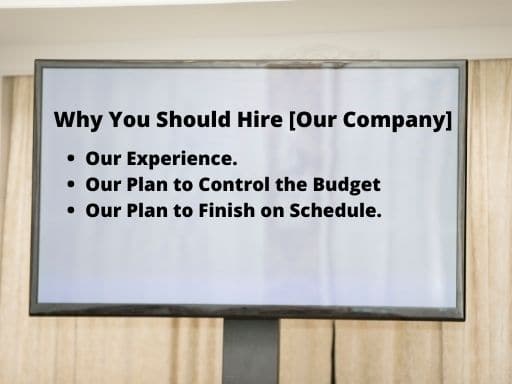
Your team is one of just six to eight other companies competing for this contract. How do you make sure that the committee picks your team? Well, not to brag, but over the years, groups that I have coached have received over 80% of these contracts. Just follow this simple sales presentation outline, and your team will have a better shot at winning as well.
Don’t Get Hung Up on the Terms Proposal, Bid Proposal, Shortlist Presentation or Sales Presentation
By the way, don’t get hung up on the terms that I am using. People will often respond with something like, “We don’t present ‘bids’ to our potential clients.” In other cases, professional people may say, “But I’m not a salesperson. This isn’t a sales presentation.” My point is, don’t get hung up on the terms.
The process that I’m covering will help anyone who is presenting a solution to a person or group who will exchange money for this solution. The terms “Bid” and “Proposal” are standard procurement terms, which is why we are using them here.
I have heard this type of presentation called each of the following over the years.
- Bid Proposal
- RFP Presentation
- Shortlist Presentation
- Sales Presentation
- Present a Quote
Regardless of what your industry calls this speech, the process will still work. For additional details, see Speak Persuasively.
Focus on What the Audience Wants, Not What You Want them to Do.

Title: Why You Should Hire [Our Company]
- [Our Company] Has Lots of Experience.
- [Our Company] Can Save You Money.
- [Our Company] Will Finish on Schedule.
Here is my most important tip. If you’re saying your company name over and over throughout the presentation, you’ve already lost. The presentation shouldn’t be about you. When you present a bid proposal, the entire presentation should be about them.
Before I get a chance to explain, a lot of people who hear this will argue with me. “Doug, that is the whole point of the sales presentation. We talk about why we should be chosen.” Falling into that trap is why most teams do very poorly in these presentations.
An Example of Why Your Audience Doesn’t Care About You.

Why You Should Hire [Our Company]
Are you ask me why I should hire you? Well, here is your answer, “I have no clue.” I don’t know you. I thought you were going to tell me how you could help me fix my problems. Here is a question for you. Why didn’t you just tell me why I should hire you? If you had started that way, I wouldn’t think that you are wasting my time, right now… Which I do.
[Our Company] Has Lots of Experience.
Well aren’t you special? Why don’t we sit and let you regale us with all of your past accomplishments? No, we have plenty of time. In fact, we are going to applaud you as you tell us about each conquest.
[Our Company] Can Save You Money.
Finally! Something that I really care about — saving money. However, somehow, you still made this whole section about you. Don’t you even care in the least about helping us in this project?
[Our Company] Will Finish on Schedule.
Well I would hope so. That is what you are promising to do when you sign a contract with us. Now that you mention it, we might want to get some type of guarantee that you will finish on time.
As you can see, any time you focus on yourself and your greatness, it sounds like bragging. You can turn off your audience even before you start speaking.
A Better Way to Present Your Business Proposal

Change “[Our Company] Can Save You Money” to something a little more tangible. Just tell the audience HOW you can save them money without mentioning your company name. This might look like, “Hiring a Design-Build Firm with Architects, Engineers, and Builders on Staff Will Give You an Economy of Scale.” For my own company, we save clients money by having instructors in every major city. So, I could create a bullet-like, “A Local Instructor Can Save You Over $1200 in Travel Fees.”
You can also make the schedule bullet better. “A Thorough Pre-construction Process Will Make Sure that Fewer Change Orders Develop During Construction. This Will Ensure that the Project Stays on Schedule.” For my own company, a bullet-like, “A 2-Day Seminar and Three Weekly Webinar Sessions Will Solidify the Skill Development Within Your Set Schedule.”
The point is to figure out what the potential client wants, and then show them how to get it.
Now, Use Your Experience to Prove That The Audience Can Get What They Want
Keep in mind that when you present a bid proposal, the client already assumes you are qualified. Chances are, they spent quite a bit of time going through all of the proposals. They only chose to interview ones that they already deemed qualified. What they want to know now is, “Do we like these people? Can we work with them?” When you create a great sales presentation outline focusing on what they want, you have a good start. They are already thinking, “These people get us.” Now, you need to make sure they like and trust you. A good way to do this is by sharing both success stories.
For each bullet point, tell a success story about how you have helped someone else fix that problem. If you design a really good, audience-focused bullet point, this should be easy. For instance, on the ones that I created earlier, I have tons of examples to choose from. A couple of years ago, we had a client who wanted four classes to be conducted simultaneously in four different cities. Because we had instructors in each of the four cities, we saved the client over $4,000 in travel fees. On another occasion, a company hired me to train their convention speakers in a series of three webinars. Then, I traveled to the convention a day ahead of the start to coach many of them one-on-one. The combination of in-person training and virtual training saved a lot of time.
These success stories prove that I can help the listeners solve a similar problem because I’ve done it before.
You Can Also Build Rapport by Discussing Your Failures
“What? You want me to tell this potential great customer how I failed?”
Yup.
Obviously, you don’t want to lead with a failure or tell the audience about a series of failures. That would make you appear incompetent. However, you can pick one bullet to tell them about a bad experience. Then, tell the audience how your team learned from the failure. Finally, finish the explanation with a success story based on the lesson learned. The potential new client knows you aren’t perfect. They want to know how you will fix the inevitable problems that could occur.
Five years ago, a huge mining company hired us to make their safety training more fun. We spent months planning. We even got one of our popular team-building activities certified for continuing education. The program was a fun team-building activity where we donated bicycles to charity. Ordering the bikes and having them shipped to arrive just in time was the challenge. The training was for 3900 miners over a three-week period.
My team verified that the bikes were delivered before flying in. However, when we arrived, the bike company had shipped the wrong bikes. We had almost 600 six to eight-year-old kids waiting for new bikes. The bike company (I’m not going to mention their name, but it was Huffy) shipped bikes for four-year-old kids.
It was a huge problem. My team went to every Wal-Mart in town buying bikes off the shelf, and we spent all night disassembling them. The participants never knew there was a problem.
As a result, we started manufacturing our own bikes. As far as I know, we are the only company now that can ship hundreds of bikes to events with as little as three days of notice because we found a solution to the problem.
Remember, When You Present a Bid Proposal, The Audience Want to Know If They Can Trust You.
By slipping in a single “failure” story like the one above, you can build trust with the group. Just finish the story with your lesson learned and add a success story to it.
For me, I’d just add a story about how one of my competitors called me up in a panic on a Thursday night. He needed 70 bikes delivered to a hotel in Dallas by Friday morning. My warehouse team rented a truck and had the bikes to him by 9:00 AM the next morning.
By sharing a lesson-learned story in conjunction with a success story, we show the audience that we fix problems. That is good since the reason they are listening to you is that they have a problem.
If You Have a Big Sales Presentation or Proposal Presentation Coming Up, We Can Help.
Opportunities to close really big deals via a presentation are pretty nerve racing. We all want every, single advantage that we can get when we walk into the room. So, if you want to ace your next short-list presentation or RFP presentation, one of our coaches can help. Complete the form below, and one of our instructors will contact you.

